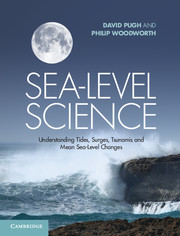Book contents
- Frontmatter
- Contents
- Preface
- List of acronyms
- List of main symbols
- Chapter 1 Introduction
- Chapter 2 Sea-level measuring systems
- Chapter 3 Tidal forces
- Chapter 4 Tidal analysis and prediction
- Chapter 5 Tidal dynamics
- Chapter 6 Shallow-water and coastal tides
- Chapter 7 Storm surges, meteotsunamis and other meteorological effects on sea level
- Chapter 8 Tsunamis
- Chapter 9 Spatial variations in sea level
- Chapter 10 Mean sea-level changes in time
- Chapter 11 Sea-level changes in time to do with the solid Earth
- Chapter 12 Sea-level applications
- Chapter 13 Sea level and life
- Appendix A Basic hydrostatic and hydrodynamic equations
- Appendix B Currents
- Appendix C High and low water times and heights from harmonic constituents
- Appendix D Theoretical tidal dynamics
- Appendix E Legal definitions in the coastal zone
- Glossary
- Index
- References
Chapter 4 - Tidal analysis and prediction
Published online by Cambridge University Press: 05 May 2014
- Frontmatter
- Contents
- Preface
- List of acronyms
- List of main symbols
- Chapter 1 Introduction
- Chapter 2 Sea-level measuring systems
- Chapter 3 Tidal forces
- Chapter 4 Tidal analysis and prediction
- Chapter 5 Tidal dynamics
- Chapter 6 Shallow-water and coastal tides
- Chapter 7 Storm surges, meteotsunamis and other meteorological effects on sea level
- Chapter 8 Tsunamis
- Chapter 9 Spatial variations in sea level
- Chapter 10 Mean sea-level changes in time
- Chapter 11 Sea-level changes in time to do with the solid Earth
- Chapter 12 Sea-level applications
- Chapter 13 Sea level and life
- Appendix A Basic hydrostatic and hydrodynamic equations
- Appendix B Currents
- Appendix C High and low water times and heights from harmonic constituents
- Appendix D Theoretical tidal dynamics
- Appendix E Legal definitions in the coastal zone
- Glossary
- Index
- References
Summary
By what astrology of fear or hope
Dare I to cast thy horoscope!
By the new Moon thy life appears;
Longfellow, To a child
Tidal analysis of data collected by observations of sea levels and currents has two purposes. Firstly, a good analysis provides the basis for predicting tides at future times, a valuable aid for shipping and other operations. Secondly, the results of an analysis can be interpreted scientifically in terms of the hydrodynamics of the seas and their responses to tidal forcing. An analysis provides parameters that can be mapped to describe the tidal characteristics of a region. Preliminary tidal analyses can also be used to check tide gauge performance, as discussed in Chapter 2.
The process of analysis reduces many thousands of numbers, for example a year of hourly sea levels consists of 8760 values, to a few significant stable numbers that contain the soul or quintessence of the record [1]. An example of statistical tidal analysis is given in the description of sea levels in Section 1.6. In tidal analysis the aim is to produce significant time-stable parameters that describe the tidal régime at the place of observation. These parameters should be in a form suitable for prediction, should be related physically to the process of tide generation, and should have some regional stability.
- Type
- Chapter
- Information
- Sea-Level ScienceUnderstanding Tides, Surges, Tsunamis and Mean Sea-Level Changes, pp. 60 - 96Publisher: Cambridge University PressPrint publication year: 2014
References
- 4
- Cited by



